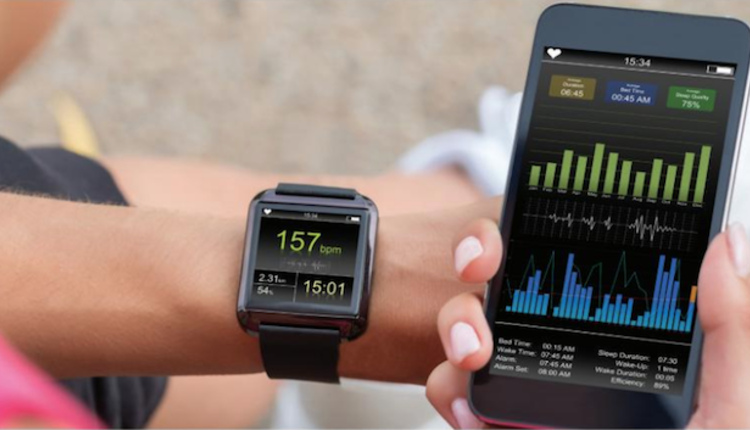
An average client sees a fitness professional three times a week; that’s a total of about three hours. Three hours out of 168 hours in a week; 12 hours out of 672 in a four-week span. One of the most challenging tasks as a trainer and coach is to monitor and optimize the hours and days we don’t see our clients. As a result of the strides and accessibility to technology, particularly wearables, it makes it easier than ever to not only see how your clients are performing, but creates the opportunity to create more consistent lifestyle patterns and optimize training sessions.
Over the past five years, wearables have been one of the top fitness trends every year and will likely continue to be for some time. The consecutive growth is a result of the ability to more accurately measure data, the advanced research on this data, and most importantly, the cost of attaining this data has significantly decreased. This technology is now more accessible to the general public without advanced testing. What used to only be measured in doctors’ offices or high-tech sports labs for thousands of dollars, are now measured at the click of a button from an app or a convenient wearable device at a fraction of the cost.
The most popular current wearables and technology primarily focus on what is happening to your body in the current moment. Some examples are heart rate monitors, step counters, GPS trackers, or self-reporting apps such as calorie counters and fitness apps. These are great options to look at several aspects such as distance traveled, effort given, overall calories burned during workouts or even to simply remind us to stand up after sitting too long. But what about the value of a person’s overall health trends that is happening over a course of a day, week, or month? Enter the 24-hour wearable technology!
The latest and most advanced wearable technology is now focused on overall body health. To do this, this technology is not only looking at real-time data such as current workout heart rate, calories burned, miles completed, pace, intensity or steps; this wearable technology focuses on other variables that are designed to be analyzed as trends. The two most significant numbers are resting heart rate (RHR) and heart rate variability, (HRV). As fitness professionals, we understand the value of these numbers as valuable indicators of health, but we now have the opportunity to easily integrate this technology to educate our clients and adjust our programming.
HRV is a measure of the variation in the time between each heartbeat in milliseconds. For example, if your RHR is 60 beats per minute (BPM), that doesn’t actually mean your heart beats once per second. You could have consecutive beats of 0.90 seconds, 1.10 seconds 0.89, 0.95, 1.13, and so on. A healthy heart rate has healthy variability to it, therefore the higher variability you have, the healthier your body currently is. HRV should be measured at rest and is not attainable without proper technology; however, RHR is more easily measured by either technology or simply taking your resting heart rate each morning and documenting it. Most 24-hour wearable technology can now measure RHR.
Why are these numbers so valuable to a trainer and client? And, more important, how do we use them? There is ongoing extensive research available on RHR and HRV. Although there are optimal ranges, (for example, an optimal average RHR is generally from 60-80 beats per minute) we care more about an individual’s daily measurements in comparison to their trending averages, not their daily measurement as a standalone metric.
Have you ever had a client that seems to be doing everything right in the gym and not making any significant progress? This is where more data can help. Several factors can negatively affect training, which affects RHR and HRV. Some examples are stress, lack of quality sleep, overtraining, inadequate hydration or nutrition, a compromised immune system, or even something as simple as seasonal allergies. This is where a client’s data can significantly change how you train them.
Here’s an example: If John’s average RHR over a span of a month is 58 beats per minute, and we see a few days of 62-65 beats per minute, that usually means his body is fatigued or not recovering from activity or his lifestyle habits over the previous days. Giving him a brutal, butt-kicker of a workout may not be the best idea. Had you not seen this data, you would likely continue to train him as his program dictates, potentially leading to negative effects on his progress. When assessing the data, you may find that he has had too little sleep over the past several days, or he had been doing more activity than normal on his off days. So instead of giving him a tough workout or trying to ramp-up his heart rate for points and calories, he may be better off focusing on recovery. Many preferred methods for recovery are body work, massage, cryotherapy, low-level corrective and mobility work, and a reminder to take a day off and go to bed a little earlier.
The most exciting aspect of the increasing technology is that there will soon be wearables for the general public which will monitor even more advanced biometrics such as insulin, cortisol, and other blood markers. As trainers and coaches, we need to understand that we can only do so much in the few hours we work with a client; but getting our clients and athletes to focus on the things that need to happen on a regular basis outside of the gym will significantly and positively impact their progress and training. It starts with us to understand the research and data in order to educate ourselves and train our clients more effectively.

















